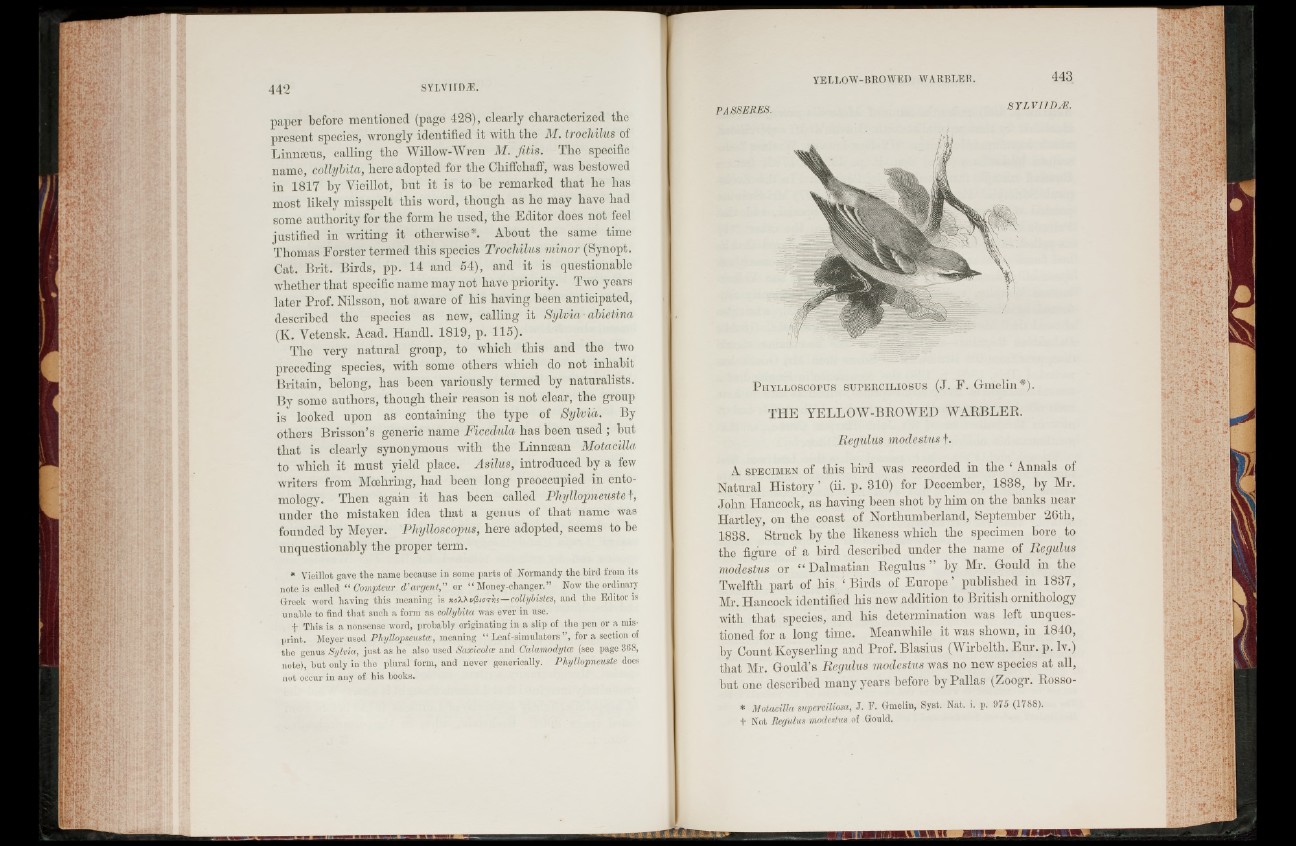
paper before mentioned (page 428), clearly characterized the
present species, wrongly identified it with the JIT. trocliilus oi
Linmeus, calling the Willow-Wren M. fitis. The specific
name, collybita, here adopted for the Chiffcliaff, was bestowed
in 1817 by Vieillot, but it is to be remarked that he has
most likely misspelt this word, though as he may have had
some authority for the form he used, the Editor does not feel
justified in writing it otherwise*. About the same time
Thomas Forster termed this species Trochilus minor (Synopt.
Cat. Brit. Birds, pp. 14 and 54), and it is questionable
whether that specific name may not have priority. Two years
later Prof. Nilsson, not aware of his having been anticipated,
described the species as new, calling it Sylvia abietina
(Iv. Vetensk. Acad. Handl. 1819, p. 115).
The very natural group, to which this and the two
preceding species, with some others which do not inhabit
Britain, belong, has been variously termed by naturalists.
By some authors, though their reason is not clear, the group
is looked upon as containing the type of Sylvia. By
others Brisson’s generic name Ficedula has been used ; but
that is clearly synonymous with the Linnsean Motacilla
to which it must yield place. Asiliis, introduced by a few
writers from Moehring, had been long preoccupied in entomology.
Then again it has been called Phyllopneuste t,
under the mistaken idea that a genus of that name was
founded by Meyer. Phylloscopus, here adopted, seems to be
unquestionably the proper term.
* Vieillot gave the name because in some parts of Normandy the bird from its
note is called “ Compteur d ’argent," or “ Money-changer.” Now the ordinary
Greek word having this meaning is xoXhvfiiarns—eollybistes, and the Editor is
unable to find th a t such a form as collybita was ever in use.
f This is a nonsense word, probably originating in a slip of the pen or a misprint.
Meyer used Phyllopseustce, meaning “ Leaf-simulators” , for a section of
the genus Sylvia, just as he also used Saxicolce and Calamodytce (see page 368,
note), but only in the plural form, and never generieally. Phyllopneuste does
not occur in any of his books.
P h y l lo s c o pu s s u p e r c il io s u s (J. F. Gmelin*).
THE YELLOW-BROWED WARBLER.
Regulus modestus f.
A s p e c im e n of this bird was recorded in the ‘ Annals of
Natural History ’ (ii. p. 310) for December, 1838, by Mr.
John Hancock, as having been shot by him on the banks near
Hartley, on the coast of Northumberland, September 26tli,
1838. Struck by the likeness which the specimen bore to
the figure of a bird described under the name of Regulus
modestus or “ Dalmatian Regulus” by Mr. Gould in the
Twelfth part of his. ‘ Birds of Europe’ published in 1837,
Mr. Hancock identified his new addition to British ornithology
with that species, and his determination was left unquestioned
for a long time. Meanwhile it was shown, in 1840,
by Count Keyserling and Prof. Blasius (Wirbelth. Eur. p. lv.)
that Mr. Gould’s Regulus modestus was no new species at all,
but one described many years before by Pallas (Zoogr. Rosso-
* Motacilla superciliosa, J. F. Gmelin, Syst. Nat. i. p. 9/5 (1788).
+ Not Regulas modestus of Gould.